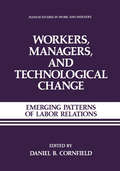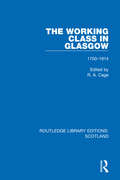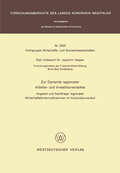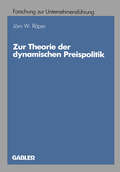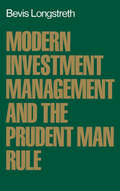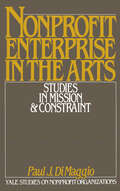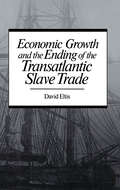- Table View
- List View
Women’s Occupational Mobility: A Lifetime Perspective
by Shirley DexInformation about women's occupational mobility is required to resolve issues about women's role in class analysis, about theories of the operation of labour markets, and for understanding changes in the industrial structure. This book addresses the questions of how women move between jobs over their lifetime, how much downward occupational mobility they experience, and how many recover their status after downward moves. Results of exciting new data are integrated with current theoretical problems to make this book widely relevant to academics, policy makers and women's groups.
Work and Industry: Structures, Markets, and Processes (Springer Studies in Work and Industry)
by Arne L. Kalleberg Ivar BergWork occupies a pivotal role in the daily activities and over the course of a lifetime of members of modern societies. In anticipation, work influ ences education and training; it has much to do with shaping current earned income and status in the community; and in retrospect, it influ ences retirement income and activities. It is a powerful force affecting personal associations. In our society work is deeply encased in moral and religious values: As Poor Richard says, A Life of Leisure and a Life of Laziness are two Things. Do you imagine that Sloth will afford you more Comfort than Labour? No, for as Poor Richard says: ... Industry gives Comfort, and Plenty and Respect. Study to show thyself approved unto God a workman that needeth not to be ashamed. But few words have as many different meanings and nuances as "work": to forge or to shape, to stir or to knead, to solve, to exploit, to practice trickery for some end, to excite or to provoke, to persuade or to influence, to toil, and the like. A need for precision in meaning is requisite with respect to work, not only in common discourse, but, even more so, in scholarly communication.
Work Out Accounting GCSE (Macmillan Work Out)
by Paul StevensWork Out Accounting GCSE has been written to cover all the syllabuses set by the major examining boards. Each chapter commences with an explanation of the accounting principles relating to a topic and the approach to be used in tackling examination questions in that area. This is followed by a section of fully worked examples and then a section of further questions for the reader to try.
Workers, Managers, and Technological Change: Emerging Patterns of Labor Relations (Springer Studies in Work and Industry)
by Daniel B. CornfieldWorkers, Managers, and Technological Change: Emerging Patterns of Labor Relations contributes significantly to an important subject. Technological change is one of the most powerful forces transforming the American industrial relations In fact, the synergistic relationships between technology and indus system. trial relations are so complex that they are not well or completely understood. We know that the impact of technology, while not independent of social forces, already has been profound: it has transformed occupations, creating new skills and destroying others; altered the power relationships between workers and managers; and changed the way workers learn and work. Tech nology also has made it possible to decentralize some economic activities out of large metropolitan areas and into small towns, rural areas, and other coun tries. Most important, information technology makes it possible for interna tional corporations to operate on a global basis. Indeed, some international corporations, especially those based in the United States, are losing their national identities, detaching the welfare of corporations from that of particu lar workers and communities. Internationalization, facilitated by information technology, has trans formed industrial relations systems. A major objective of the traditional American industrial relations system was to take labor out of competition.
The Working Class in Glasgow: 1750-1914 (Routledge Library Editions: Scotland #4)
by R. A. CageOriginally published in 1987, this book examines how much industrialisation improved the standard of living of the British worker, based on the experience of one representative city: Glasgow. It analyses whether there was an increase in skilled as opposed to unskilled labour in major industrial centres – as for example in Glasgow, manufacturing shifted from textiles to engineering. Other important issues such as the rate of housing construction, public health, local politics and leisure pursuits are also considered. Glasgow has a long history of working-class culture and is therefore a particularly interesting city to study.
The Working Class in Glasgow: 1750-1914 (Routledge Library Editions: Scotland #4)
by R. A CageOriginally published in 1987, this book examines how much industrialisation improved the standard of living of the British worker, based on the experience of one representative city: Glasgow. It analyses whether there was an increase in skilled as opposed to unskilled labour in major industrial centres – as for example in Glasgow, manufacturing shifted from textiles to engineering. Other important issues such as the rate of housing construction, public health, local politics and leisure pursuits are also considered. Glasgow has a long history of working-class culture and is therefore a particularly interesting city to study.
Working with People Tutor Guide (Macmillan Updating for Business)
by Open Business and Technician Educational CouncilWorld Hunger And The World Economy: And Other Essays In Development Economics
by Keith GriffinWritten in a style that makes it accessible to everyone interested in development studies, not just to economists, the focus of this collection of essays is on hunger, poverty and inequality. Much of the content of the book is based on the author's first-hand experience in, for example, Ethiopia and China, and his views on foreign aid and the debt crisis will make controversial and provocative reading.
Zentrale und dezentrale Energieversorgung: VDE/VDI/GFPE-Tagung in Schliersee am 7./8. Mai 1987 (FfE - Schriftenreihe der Forschungsstelle für Energiewirtschaft #18)
by Helmut SchaeferIn zunehmendem Maße sind Vorstellungen über die Gestaltung der Energieversorgung in der Bundesrepublik, wie sie besonders in der Diskussion um "zentrale" oder "dezentrale" Technik zum Ausdruck kommen, heute von gesellschaftspolitischem und weltanschaulichem Denken beeinflußt. Technische und selbst ökonomische Sachverhalte und Argumente treten demgegenüber stark in den Hintergrund; vielfach wird sogar der Eindruck erweckt, als seien sie für die Beurteilung dezentraler Technik nicht von Bedeutung. Die Tagung hat zum Ziel, sich vor allem mit den Techniken und Systemen zur "dezentralen" Energieversorgung auseinanderzusetzen und aufzuzeigen, wo und wie sie sinnvoll eingesetzt werden können, welchen Einschränkungen ihre Anwendung und ihr Beitrag zur Energieversorung unterliegt. Dadurch soll deutlich werden, daß die Denkweise "zentral oder dezentral" in die Irre führt, daß vielmehr nur die richtige und sinnvolle Nutzung aller Versorgungstechniken eine optimale Energiebedarfsdeckung gewährleistet. Besonderes Gewicht wird auf die Darstellung von Erfahrungen aus der praktischen Erprobung gelegt, da viele Vor- und Nachteile neuer technischer Systeme sich erst hieraus offenbaren.
Zinsrisiko-Management in Banken (Schriftenreihe des Instituts für Kredit- und Finanzwirtschaft #13)
by Michael BangertZur Dynamik regionaler Arbeits- und Investitionsmärkte: Angebot und Nachfrage regionaler Wirtschaftsfördermaßnahmen im Konjunkturverlauf (Forschungsberichte des Landes Nordrhein-Westfalen #3223)
by Joachim VesperZur Theorie der dynamischen Preispolitik (Betriebswirtschaftliche Forschung zur Unternehmensführung #19)
by Jörn W. RöperSeitdem die statische Preistheorie und die darauf aufbauenden preispolitischen Überlegun gen einen relativ hohen Entwicklungs-und Erkenntnisstand erreicht haben, sind die Bemü hungen auf dem Gebiet der Preistheorie und der Preispolitik vornehmlich darauf gerichtet, dynamische Einflüsse zu erfassen und in die Betrachtung einzubeziehen. Während die statische Theorie bei der Erörterung der Preisbildung und der Bestimmung und Ableitung der jeweiligen zieladäquaten Preise allein die Gegebenheiten der Periode be rücksichtigt, für die der Preis zu bestimmen ist, bemüht sich die dynamische Theorie, auch die Wirkungen zu erfassen, die von den Gegebenheiten der vorgelagerten und der nachfol genden Perioden ausgehen können. Die Gegebenheiten der vorhergehenden Periode(n) finden ihren Ausdruck darin, wie die Nachfrager auf eine Preisänderung reagieren (Preisänderungsresponse). In der laufenden Periode kann - bei gleichem Preis - die Nachfrage unterschiedlich hoch sein je nachdem, ob der in dieser Periode geltende Preis dem Preis der Vorperiode gleich ist oder ihn über trifft oder unterschreitet. Die Verhältnisse in nachfolgenden Perioden werden dann eine Wirkung haben, wenn mit sogenannten Carryover-Effekten gerechnet werden muß. Ein Carryover-Effekt liegt vor, wenn der Preis der laufenden Periode auch den Absatz in späteren Perioden beeinflußt.
Modern Investment Management and the Prudent Man Rule
by Bevis LongstrethIn recent years the field of finance has exploded with innovation. New products, services and techniques abound. The risks of inflation, the volatility of interest rates, the deregulation of financial intermediaries and the unbundling of financial services have combined to present investment managers with challenges and opportunities far greater than in the past. For trustees and managers of pension, trust, endowment, and similar funds, the task of meeting the challenges and exploiting the opportunities is much more difficult. These fiduciaries must measure their investment decisions against constrained interpretations of a legal standard--the prudent man rule--that have caused it to lag far behind changes in investment theory and the marketplace. Drawing on financial history, a major opinion survey of institutional investors, and comprehensive reviews of the law and of the lessons of modern portfolio theory for prudence, this book presents a powerful case that the prudent man rule as elaborated in legal treatises and much of the case law would virtually compel a fiduciary to act imprudently in terms of financial theory and marketplace reality. In proposing a modern paradigm of investment prudence, the book uses illustrations drawn from such traditionally suspect categories of investment fiduciaries as securities lending, real estate, venture capital, options and futures and repurchaser agreements. An unusual examination of the interaction of the worlds of law and finance, this work will be of interest to fiduciaries who are subject to some from of prudent man rule and all others, including judges, lawyers and investment managers, who are called upon to interpret and apply that legal standard.
Nonprofit Enterprise in the Arts: Studies in Mission and Constraint (Yale Studies on Non-Profit Organizations)
by Paul J. DiMaggioTaking the dichotomy of nonprofit "high culture" and for-profit "popular culture" into consideration, this volume assesses the relationship between social purpose in the arts and industrial organization. DiMaggio brings together some of the best works in several disciplines that focus on the significance of the nonprofit form for our cultural industries, the ways in which nonprofit arts organizations are financed, and the constraints that patterns of funding place on the missions that artists and trustees may wish to pursue. Showing how the production and distribution of art are organized in the United States, the book delineates the differing roles of nonprofit organizations, proprietary firms, and government agencies. In doing so, it brings to the surface some of the special tensions that beset arts management and policy, the way the arts are changing or are likely to change, and the policy alternatives "high culture" faces.
Economic Growth and the Ending of the Transatlantic Slave Trade
by David EltisThis watershed study is the first to consider in concrete terms the consequences of Britain's abolition of the Atlantic slave trade. Why did Britain pull out of the slave trade just when it was becoming important for the world economy and the demand for labor around the world was high? Caught between the incentives offered by the world economy for continuing trade at full tilt and the ideological and political pressures from its domestic abolitionist movement, Britain chose to withdraw, believing, in part, that freed slaves would work for low pay which in turn would lead to greater and cheaper products. In a provocative new thesis, historian David Eltis here contends that this move did not bolster the British economy; rather, it vastly hindered economic expansion as the empire's control of the slave trade and its great reliance on slave labor had played a major role in its rise to world economic dominance. Thus, for sixty years after Britain pulled out, the slave economies of Africa and the Americas flourished and these powers became the dominant exporters in many markets formerly controlled by Britain. Addressing still-volatile issues arising from the clash between economic and ideological goals, this global study illustrates how British abolitionism changed the tide of economic and human history on three continents.
Advanced Spatial Statistics: Special Topics in the Exploration of Quantitative Spatial Data Series (Advanced Studies in Theoretical and Applied Econometrics #12)
by Daniel A. GriffithIn recent years there has been a growing interest in and concern for the development of a sound spatial statistical body of theory. This work has been undertaken by geographers, statisticians, regional scientists, econometricians, and others (e. g. , sociologists). It has led to the publication of a number of books, including Cliff and Ord's Spatial Processes (1981), Bartlett's The Statistical Analysis of Spatial Pattern (1975), Ripley's Spatial Statistics (1981), Paelinck and Klaassen's Spatial Economet~ics (1979), Ahuja and Schachter's Pattern Models (1983), and Upton and Fingleton's Spatial Data Analysis by Example (1985). The first of these books presents a useful introduction to the topic of spatial autocorrelation, focusing on autocorrelation indices and their sampling distributions. The second of these books is quite brief, but nevertheless furnishes an eloquent introduction to the rela tionship between spatial autoregressive and two-dimensional spectral models. Ripley's book virtually ignores autoregressive and trend surface modelling, and focuses almost solely on point pattern analysis. Paelinck and Klaassen's book closely follows an econometric textbook format, and as a result overlooks much of the important material necessary for successful spatial data analy sis. It almost exclusively addresses distance and gravity models, with some treatment of autoregressive modelling. Pattern Models supplements Cliff and Ord's book, which in combination provide a good introduction to spatial data analysis. Its basic limitation is a preoccupation with the geometry of planar patterns, and hence is very narrow in scope.
Advances in Optimization and Control: Proceedings of the Conference “Optimization Days 86” Held at Montreal, Canada, April 30 – May 2, 1986 (Lecture Notes in Economics and Mathematical Systems #302)
by Horst A. Eiselt Giorgio PederzoliAirline Operations Research (Routledge Library Editions: Transport Economics #3)
by Dusan TeodorovicThe increase in practical problems generated by the intensive growth in air transport has necessitated the development of specialised operations research methods and modern computer technology. By combining operational research data from both scientific publications and airline companies, this book, first published in 1988, provides a unique source of information for those working on the development and application of operations research analysis in air transportation. Topics include air transport analysis, flight frequency determination, the scheduling of flights and personnel, and the problems of airline overbooking.
Airline Operations Research (Routledge Library Editions: Transport Economics #3)
by Dusan TeodorovicThe increase in practical problems generated by the intensive growth in air transport has necessitated the development of specialised operations research methods and modern computer technology. By combining operational research data from both scientific publications and airline companies, this book, first published in 1988, provides a unique source of information for those working on the development and application of operations research analysis in air transportation. Topics include air transport analysis, flight frequency determination, the scheduling of flights and personnel, and the problems of airline overbooking.
Aktionsorientierte Datenverarbeitung im Fertigungsbereich (Betriebs- und Wirtschaftsinformatik #27)
by Jürgen HofmannAll-Change in the City: The Revolution in Britain’s Financial Sector
by Margaret ReidAn analysis placing London in its global setting and tracing with new detail, the origins of the "Big Bang". It attempts to analyze the less familiar evolution of city institutions, including the big banks whose business is examined with particular emphasis on the Bank of England.




